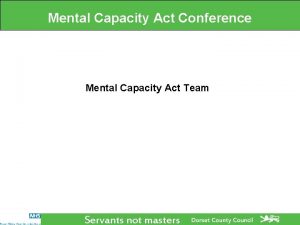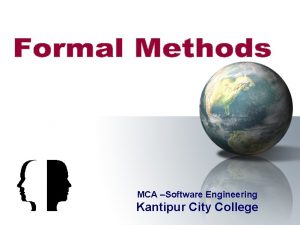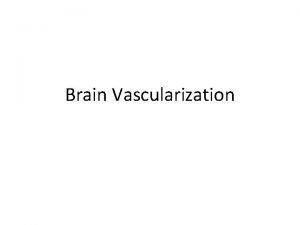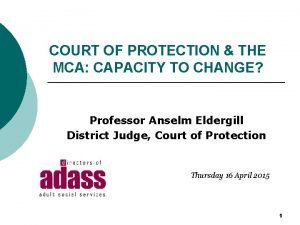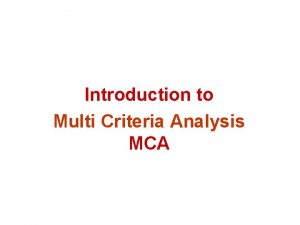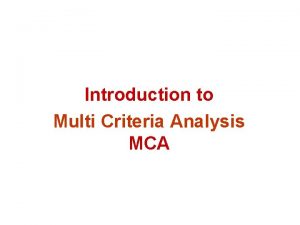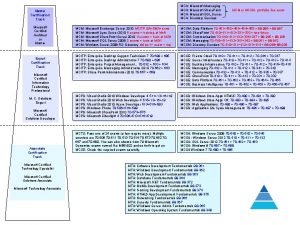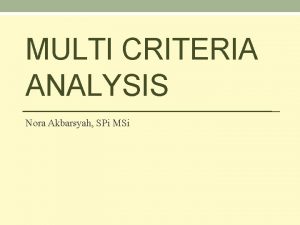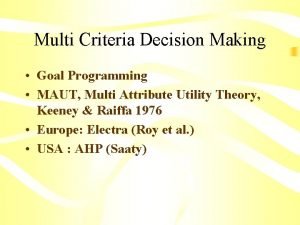Introduction to Multi Criteria Analysis MCA Multi Criteria








- Slides: 8

Introduction to Multi Criteria Analysis MCA

Multi Criteria Decision Analysis MCDA is both an approach and a set of techniques, with the goal of providing an overall ordering of options, from the most preferred to the least preferred option. The options may differ in the extent to which they achieve several objectives, and no one option will be obviously best in achieving all objectives. In addition, some conflict or trade-off is usually evident amongst the objectives; options that are more beneficial are also usually more costly, for example. Costs and benefits typically conflict, but so can short-term benefits compared to longterm ones, and risks may be greater for the otherwise more beneficial options. MCDA is a way of looking at complex problems that are characterized by any mixture of monetary and non-monetary objectives, and to present a coherent overall picture to decision makers. The purpose is to serve as an aid to thinking and decision making, but not to take the decision.

Steps in Multi Criteria Analysis

Multi Criteria Analysis • Score card: • represents the impacts of alternative strategies on criteria • aims to rank alternative strategies when the effect of these strategies cannot be translated into one single measuring scale Wt. Alt. 1 Alt. 2 Alt. 3 Criterion 1 1 good v. good bad Criterion 2 2 +++ 0 -- Criterion 3 1. 5 5. 5 9 2 Criterion 4 2 - 0. 3 + 0. 5 Criterion 5 3 20, 000 50, 000 30, 000 ? ? ? Total score

Multi Criteria Analysis • Weighting: The weighting approach involves assigning a relative weight to each objective/criteria • Cautions • Avoid double counting (e. g. groundwater level and cost of pumping) • Specification of units (negative or positive, best or worst) • Score cards represent one scenario • Score card are made for one time horizon • Be aware of uncertainties

Multi Criteria Analysis • Approaches: • Weighted sum method • Pairwise comparison (concordance index) • Standardization Methods • Subjective/qualitative scores can be translated into 1 -10 scale • For Quantitative scores the following formula can be applied:

Multi Criteria Analysis • Weighted Sum: Wt. Alt. A Alt. B Criterion 1 1 0. 9 0. 1 Criterion 2 2 0. 4 0. 5 Criterion 3 2 0. 4 0. 6 2. 5 2. 3 Wtd Sum • Concordance : • Concordance index: KAB = to what degree alt A is better than alt B KAB = 1 (A scores better than B for Criterion 1 with weight 1) KBA = 2+2 = 4 (B scores better than A for criteria 2 and 3) KBA - KAB = 3 (the higher indicates the degree to which B dominates A)

MCA Example The following table include some data about the different technologies for brackish water purification. We wish to select which technology is best for Gaza ? ? Brackish EDR Brackish RO Barckish IX 130000 100, 000 110000 O&M cost ($/m 3) 0. 3 0. 25 0. 35 recovery rate (%) 95% 70% 97% moderate high low 100 150 250 -1 -3 -2 moderate high low Criteria capital cost suitability to gaza water quality of water (TDS) environmental impacts availability of membranes and chemicals Wt.
